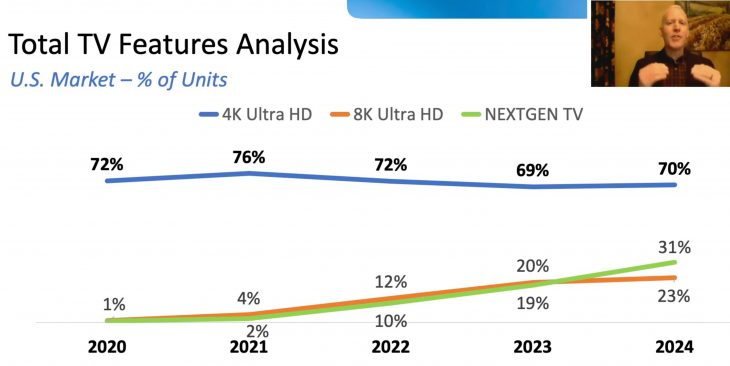
By John Bugailiskis
WASHINGTON – Building on the initial rollout of NextGen TV (ATSC 3.0) over-the-air broadcasting that has reached more than 20 cities and 80 TV stations, America’s broadcasters have targeted nearly 20 more cities by the end of the summer. Pearl TV, a business group comprised of owners of more than 750 broadcast stations, and the Phoenix Model Market partners announced the plans at the virtual 2021 CES.
“We anticipate that NextGen TV will reach about 70% of U.S. household by the end of 2021,” said ATSC president Madeleine Noland during the kick-off a CES 2021 panel on the new broadcasting standard last week. NextGen TV is an Internet Protocol (IP) based system which can carry internet content and services alongside traditional over-the-air broadcast signals. It represents the first major upgrade in broadcast TV since the transition to digital broadcasting (DTV) in 2009.
NextGen TV will enable interactive features like video-on-demand and advanced emergency alerts for broadcast TV, all delivered free with an over-the-air antenna. NextGen TV signals will be stronger and will transmit over greater distances and farther into buildings, with higher-quality picture and better sound. Last year, TV set manufacturers Samsung, Sony and LG together launched more two-dozen TVs with ATSC 3.0 tuners and even more were launched during CES 2021.
“Broadcasters are working like never before to launch new NextGen TV channels that offer better picture and more expansive audio options for viewers. As the consumer technology industry begins to diversify its choices with more models and more affordable products for viewers, broadcasters will continue to push ahead with plans to initiate NextGen TV service in key markets throughout the country. We’re also doing our part to help to educate consumers about the benefits of NextGen TV,” said Pearl TV managing director Anne Schelle.
According to data presented at CES 2021 by the Consumer Technology Association (CTA), NextGen TV shipments in the U.S. will approach 25 million units by the end of 2024. Steve Koenig, vice-president of research, CTA, predicts 31% of all TVs will ship with ATSC 3.0 tuners by 2024.
Work is also now underway to develop cable compatibility standards for NextGen TV, and American broadcasters are introducing an interactive application in select cities that uses a common “application framework” developed by Pearl TV and the Phoenix Model Market Partners. The new framework provides users with the ability to access more news content, including weather and emergency alert information that is integrated with live broadcasts. The application platform is now open for third party developers.
Additionally, TV broadcasters in Detroit recently launched a co-operative effort with the automobile industry called the “Motown 3.0 Test Track” to demonstrate the ATSC 3.0 datacasting capability of next-generation broadcasting for infotainment, emergency alerting, telematics and other data services delivered to connected cars.
“NextGen TV gives broadcasters a direct IP path to viewers at home and on-the-go. With a connected device, we know that television broadcasting will be a powerful tool for viewers who want new experiences and more content choices,” Schelle said.
We’re also encouraged by the initial rollout of NextGen TV-equipped TV receivers from LG Electronics, Samsung and Sony, and we’re expecting more TV manufacturers to join in this year as more cities sign on-air with NextGen TV. And consumers will have the availability of set-top receivers such as the ZapperBox from BitRouter and HDHomeRun Connect 4K from SiliconDust that will give consumers with existing TV sets the ability to receive NextGen TV broadcasts,” added Schelle.
Cartt.ca is aware of no Canadian broadcasters moving towards ATSC 3.0. That said…
TMT Labs brings “shoppable TV” experience to CES
In further NextGen TV news, Toronto-based TMT Lab Inc. is showcasing its new Spot Direct applications for linear OTT, AVOD, addressable TV and NextGen TV at CES.
Spot Direct has developed software architecture that maps each video frame of distributors’ playlist automation systems, creating real-time actionable data valuable to advertisers and agencies seeking to unleash unprecedented interactions and shoppable television experiences. This can range from precise TV/digital campaign coordination on Facebook, Google etc. that increase total TV plus digital ad spending ROI, to natively capturing ad responses within video distributors’ own user interfaces, or even “clicking on a TV ad” with the remote control provided by TV OEMs.
“Television’s definition has gone to countless changes in the last few years; however, one thing has not changed: advertisers’ desires of making available commercial inventories ‘clickable’ while creating frictionless shoppable television experiences at scale, says Rodrigo Madriz, co-founder and CEO of TMT Lab.
Spot Direct works with proprietary video distributors’ and/or DSP origination data and without viewers needing any special software, hardware within their premises, QR codes, or the “slower and sometimes privacy-compromised implementations of pixels and tones for video and audio recognition, respectively – which use data already in the public domain.”
TMT Lab is also showcasing its new Spot Direct – Digital Takeover service which will allow advertisers within the same vertical to trigger their digital campaigns on third party inventories immediately after their competitor has done so on linear television. This service will effectively multiply revenue generating opportunities for broadcasters, MVPDs, etc. it claims.
TMT Lab says it is now working to establish relationships with broadcasters, AVOD, addressable TV, linear OTT video distributors, MVPDs, TV set OEMs, large e-commerce players, and playout automation software vendors, as well as with the ATSC 3.0 ecosystem.



